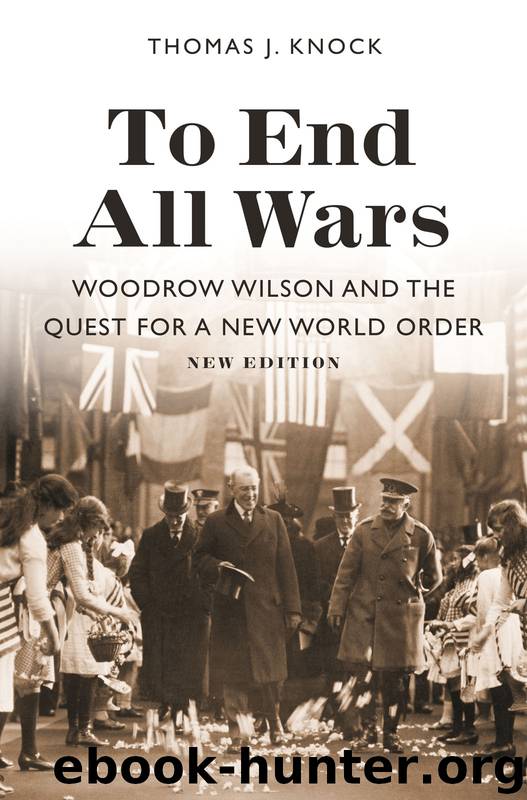To End All Wars: Woodrow Wilson and the Quest for a New World Order by Thomas J. Knock

Author:Thomas J. Knock
Language: eng
Format: epub
Publisher: Princeton University Press
Published: 2018-12-25T16:00:00+00:00
11
The Stern Covenanter
New York Harbor erupted in splendid pandemonium as the George Washington, bearing President Wilson and a small army of advisers and newspaper reporters, began its historic voyage to Europe on the morning of December 4, 1918. Naval vessels fired nineteen-gun salutes, and tugboats and ferries tied down their whistle valves. From the Hoboken waterfront and the tall buildings of Manhattan, tens of thousands of people waved handkerchiefs and threw confetti. As the liner approached the Statue of Liberty, a giant dirigible swung overhead while a squadron of airplanes “looped the loop.’’ Further out, eleven battleships made ready to escort the presidential argosy to its destination.1
Almost from the moment the George Washington sighted the coast of Brittany nine days later, any remaining doubts about Wilson’s decision to attend the peace conference had vanished. The spectacle at Brest—the cheers of the entire population of the city and banners bearing the slogans “Hail the Champion of the Rights of Man” and “Honor to the Founder of the Society of Nations”—was but a prelude. Never before in the history of France had such a demonstration taken place as the one that awaited Wilson in Paris. From the Gare des Invalides to the Arc de Triomphe, down the Champs-Élysées and across the Place de la Concorde, some two million Parisians turned out to hail the President of the United States. Along the parade route, seats in windows sold for 300 francs and young men and children climbed trees to catch a better glimpse of “Wilson, the Just.” Thirty-six thousand French soldiers held back the crowds as the procession of eight horse-drawn carriages, the first one carrying Wilson and President Raymond Poincare, passed along the avenues. Cannon boomed in the distance. Bouquets of violets rained down on Mrs. Wilson, almost burying her carriage. The cheers were deafening, even frightening. “I saw Foch pass, Clemenceau pass, Lloyd George, generals, returning troops,” wrote one American journalist, “but Wilson heard from his carriage something different, inhuman—or superhuman.”2
The scene virtually repeated itself when the President visited London, Carlisle, and Manchester the following week. After his entrance into Rome in early January—where the streets were sprinkled with golden sand, in accordance with ancient tradition, and the banners read “Welcome to the God of Peace”—it was said that Caesar had never had a grander triumph. In Milan, the ovations verged on hysteria, and Wilson was moved to tears. Enormous throngs choked the streets and inundated his automobile with papers acclaiming him “The Savior of Humanity” and “The Moses from Across the Atlantic.” At La Scala people clamored for his autograph, and his doctor saw many of those who received it kiss the signature and press it to their hearts. Throughout the country, Italian families placed sacred candles next to his photograph.3
The extraordinary tribute the peoples of Europe paid Wilson was the stuff the Allied prime ministers’ nightmares were made of. These unprecedented demonstrations transcended mere pageantry. Indeed, they were an articulate expression of mass political opinion—and one, significantly, set in motion by the liberal, labor, and socialist movements within the Allied countries.
Download
This site does not store any files on its server. We only index and link to content provided by other sites. Please contact the content providers to delete copyright contents if any and email us, we'll remove relevant links or contents immediately.
| U.K. Prime Ministers | U.S. Presidents |
Waking Up in Heaven: A True Story of Brokenness, Heaven, and Life Again by McVea Crystal & Tresniowski Alex(37004)
Empire of the Sikhs by Patwant Singh(22173)
We're Going to Need More Wine by Gabrielle Union(18074)
Hans Sturm: A Soldier's Odyssey on the Eastern Front by Gordon Williamson(16632)
Leonardo da Vinci by Walter Isaacson(11903)
The Radium Girls by Kate Moore(10907)
Educated by Tara Westover(7063)
Tools of Titans by Timothy Ferriss(6949)
How to Be a Bawse: A Guide to Conquering Life by Lilly Singh(6693)
The Last Black Unicorn by Tiffany Haddish(5075)
Permanent Record by Edward Snowden(4998)
The Rise and Fall of Senator Joe McCarthy by James Cross Giblin(4843)
Promise Me, Dad by Joe Biden(4447)
The Wind in My Hair by Masih Alinejad(4424)
The Crown by Robert Lacey(4105)
A Higher Loyalty: Truth, Lies, and Leadership by James Comey(4033)
The Iron Duke by The Iron Duke(3639)
Joan of Arc by Mary Gordon(3259)
How to be Champion: My Autobiography by Sarah Millican(3186)
